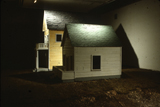From the Outskirts to the Center
| White trash (bags ) are snagged on a fence, floating and sinking gracefully in the artificial wind while empty beer cans roll with their own volition, propelled along choreographed tracks imbedded into the false forest floor. The stuff we throw away, every day litter, is sampled here in its iconic essence.The four small houses, built into the space, suggest a location on the edge of town, perhaps a fragment of a new housing development. They echo McKeough’s seminal Defunct. In that 1981 installation at The Alberta College of Art Gallery, 1/3 scale replicas of actual heritage style homes modelled after Calgary neighborhoods were built by McKeough and installed in the gallery. Over the period of the exhibition, Mckeough demolished the houses just as real homes out on the street were torn down by real estate developers. In both projects, Rita delves into sound and invests these spaces with identity and agency. The inanimate structures have become articulate; they speak, lament, sing, have feelings, express dread and anger. I am reminded of the environmental writings of David Abram: “this unknowability, this otherness, resides most often in the materials from which the object is made. The tree trunk of the telephone pole, the clay of the bricks from which a building is fashioned, the smooth metal alloy of the car door we lean against – all these still carry, like our bodies, the textures and rhythms of a pattern that we ourselves did not devise, and their quiet dynamism responds directly to our senses. ..Whenever we assume the position and poise of the human animal — Merleau Ponty’s body-subject — then the entire material world itself seems to come awake and to speak..” (1)
In the Outskirts houses, grim humour abounds. As a trope, personification is as potent as irony and here carries a powerful blend of comedy and sorrow. My favourite cabin ( #1) had three “pets”, three little mechanical dog toys seemingly possessed by demonic spirits; they wag their tails frantically, their plastic eyes glitter and blink, and as in a nightmare they frenetically scratch and strut and strain against their leashes, little paws clicking against the floor. The space is alive with sound, inane, mindless animal imitations. A catastrophic effect lingers in the damaged space; one lone, torn armchair and all the walls are scratched beyond repair, animal scratches that evoke memories of cages, urine and captivity. The alarming thing is that these mechanized entities are actual toys – twitching simulacra of pets, manufactured no doubt to supply the solace and novelty of a living animal, yet without the responsibility. |
 |
